Are you in love with the stunning White Angel Wing Begonia and wondering how to keep it thriving in your home? Maybe you’re struggling with how much light it needs, or you’re unsure about watering schedules. You’re not alone! Growing this gorgeous plant can feel a bit tricky at first, but with the right care, your White Angel Wing Begonia can flourish beautifully.
In this comprehensive guide, we’ll walk you through everything you need to know about growing and caring for this stunning variety. Whether you’re a beginner or someone with some experience in caring for houseplants, you’ll find practical tips that will help your plant thrive.
Read more:
- Top 5 Rare Begonias You Need to Know About
- Rare Begonia Rex Varieties: Discover Why They’re Worth the Effort
What is White Angel Wing Begonia?
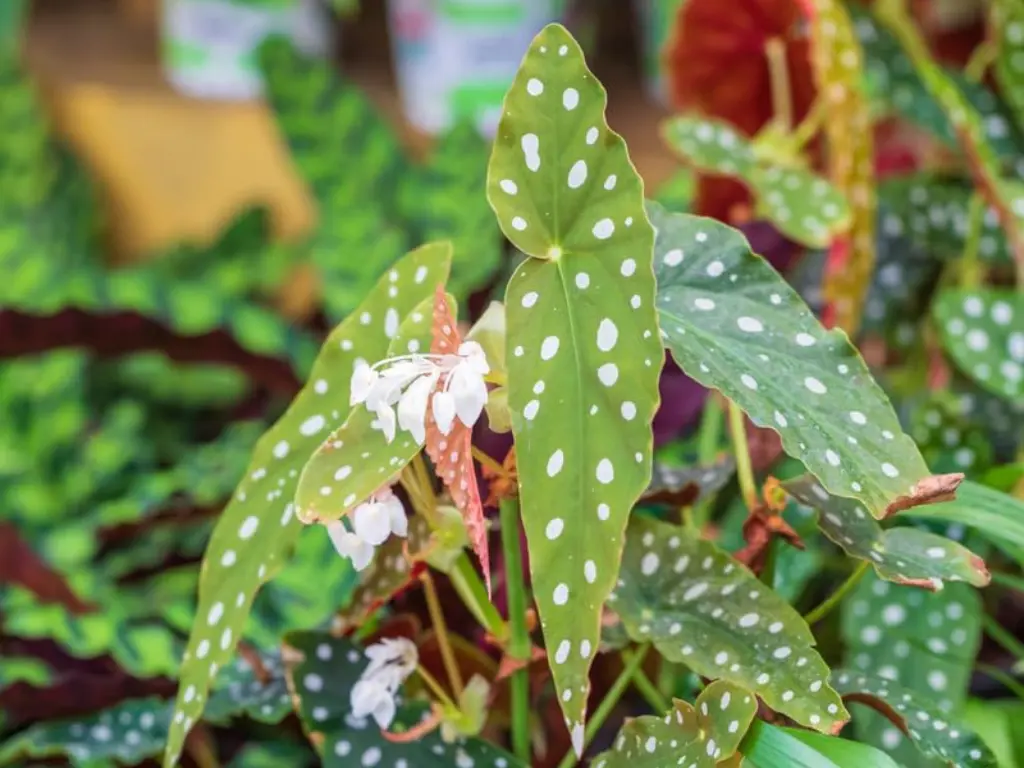
The White Angel Wing Begonia is a type of Begonia known for its striking, angel-wing-shaped leaves. With its delicate white flowers and dramatic foliage, it’s a favorite for houseplant enthusiasts. These begonias are native to tropical regions and thrive in warm, humid environments. They can be a fantastic addition to your indoor garden, adding a touch of elegance and beauty.
The main appeal of this begonia variety is its low maintenance yet stunning beauty. It can brighten up any room, and with proper White Angle Wing Begonia care, it’ll reward you with a lovely bloom season after season. Plus, caring for this plant can be very fulfilling as it’s relatively easy to grow when you follow the right steps.
Essential Tips for Growing White Angel Wing Begonia
Before diving into the specifics of care, let’s look at some basic factors to keep in mind when growing White Angel Wing Begonia indoors.
1. Choosing the Right Pot and Soil
The first step in growing a healthy White Angel Wing Begonia is selecting the proper pot and soil. Begonias like this one require well-draining soil that retains moisture without becoming soggy. Look for a soil mix designed for tropical houseplants or a mix of peat, perlite, and pine bark.
A pot with drainage holes is crucial because stagnant water can lead to root rot. Be sure to choose a pot that’s just slightly larger than the root ball to allow for growth but not too large that the plant sits in excess moisture.
2. Light Requirements
One of the most common mistakes when growing begonias is giving them too much direct sunlight. White Angel Wing Begonias thrive in bright, indirect light. Too much direct sun can scorch their delicate leaves, causing them to turn brown or curl.
Place your plant near a window with filtered light, but keep it out of direct sunlight for extended periods. A north or east-facing window is often ideal for these tropical beauties.
3. Watering
Watering is key to keeping your White Angel Wing Begonia healthy. However, overwatering can lead to root rot, while underwatering can cause the leaves to wilt and droop.
The general rule of thumb is to water the plant when the top inch of soil feels dry. Always check the moisture level before adding water. If you’re unsure, it’s safer to underwater than overwater. The soil should be moist but not soggy.
4. Humidity
Since White Angel Wing Begonias are tropical plants, they love humidity. If you live in a dry climate or use air conditioning, consider increasing the humidity around your plant. You can do this by misting the leaves regularly or placing a humidifier nearby. Alternatively, setting your plant on a tray with pebbles and water can help boost the moisture in the air around it.
Read more: Watering Tropical Plants: Secrets to Perfect Moisture
How to Care for White Angel Wing Begonia
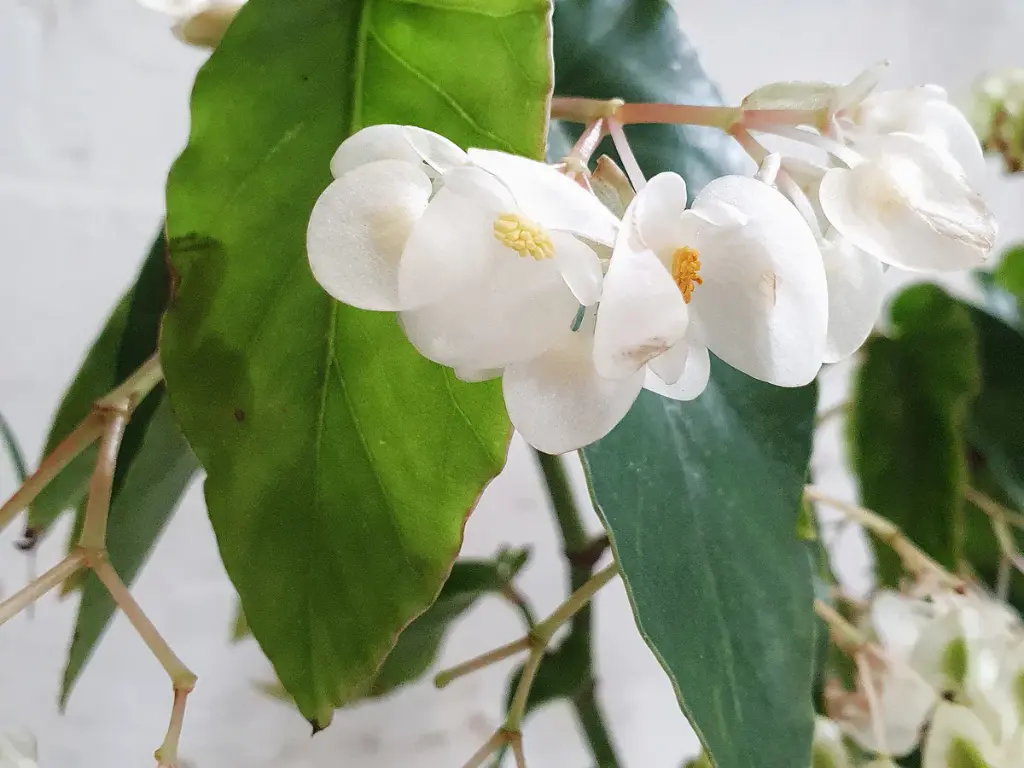
These plants prefer temperatures between 65-75°F (18-24°C). Avoid placing them near heat vents, air conditioners, or drafts that could cause temperature swings.
1. Ideal Temperature Range
While these plants love warmth, they’re not fans of extreme heat or cold. Keep them away from direct heat sources like radiators or fireplaces. They also don’t handle frost, so if your home gets chilly in winter, make sure to keep your begonia in a room that maintains a stable temperature.
2. Fertilizing
Like most houseplants, White Angel Wing Begonias need a little extra nutrition during the growing season. Use a balanced, water-soluble fertilizer diluted to half strength. Fertilize the plant once a month during the spring and summer, and reduce feeding during the fall and winter months when the plant is dormant.
3. Propagating
Propagating your White Angel Wing Begonia is easier than you might think!
To start, the best time to take cuttings is in the spring when new growth begins to appear. Here’s how you can do it:
-
Choose a healthy 2-3 inch piece from the tip of a stem that doesn’t have any blooms. Make sure it’s free from pests or damage.
-
Cut the stem just below a leaf node (where leaves meet the stem). This is where new roots will develop.
-
Insert the cutting into moist, well-draining potting soil, with the cutting side down. Gently press the soil around the cutting to ensure it’s stable and secure.
-
Keep the cutting in a warm, humid environment to encourage root growth. A small plastic bag or clear plastic dome over the cutting can help maintain humidity, but be sure to allow for some airflow to avoid mold.
While using rooting hormone can help speed up the process, it’s not essential. Angel Wing Begonias are pretty good at rooting on their own, especially when the conditions are right.
Remember, begonias are hybrids, so they won’t grow true to the parent plant if propagated from seed. Stick to cuttings for the best results and to ensure your new plants resemble the original.
The natural lifespan of a White Angel Wing Begonia is around 5-6 years. If your plant starts looking a little leggy or worn out, it’s a good idea to take fresh cuttings each spring. Old plants that aren’t thriving can be discarded or composted to make room for new growth.
Read more: How to Propagate Begonias: Easy Methods for Thriving Plants
4. Pruning and Repotting
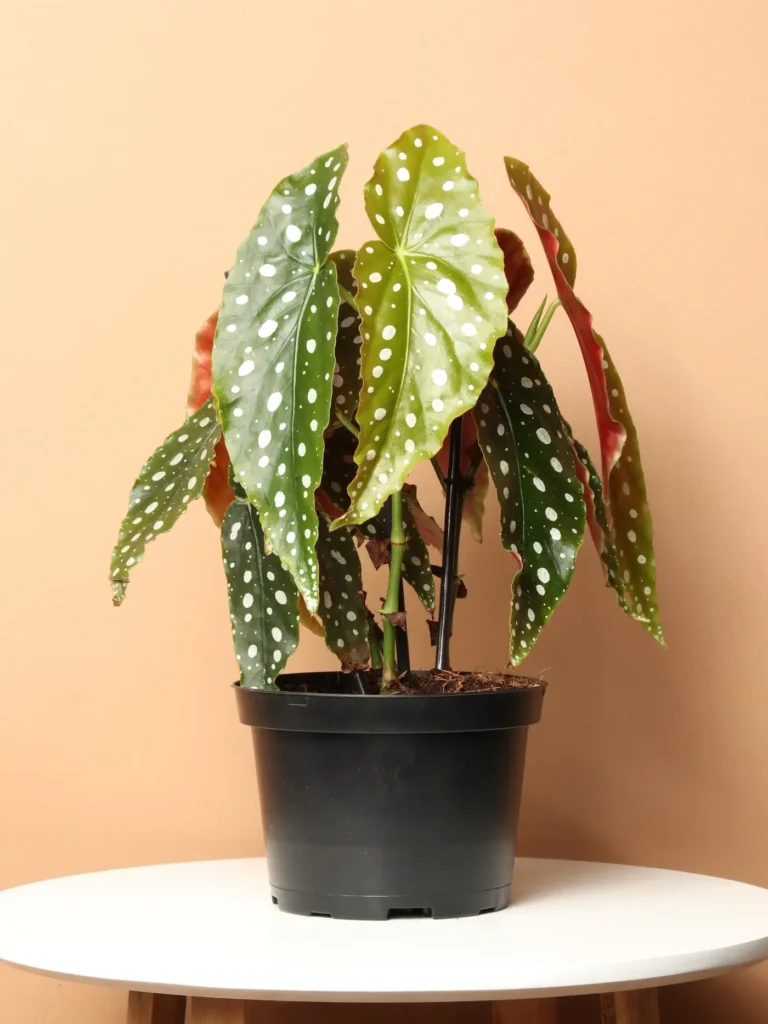
While White Angel Wing Begonias don’t require heavy pruning, regular maintenance is important for their growth and health. Remove any dead or damaged leaves to encourage new growth. You can also pinch back the tips of the plant to encourage bushier growth.
Repotting is necessary every 1-2 years or when your plant outgrows its current pot. Be sure to choose a pot that’s just one size larger to allow the roots room to grow.
5. Moving White Angel Wing Begonia Outdoors for the Summer
During the warmer months, your White Angel Wing Begonia can thrive outdoors, but it’s important to ease it into the change gradually. Since begonias are native to rainforests, they’re used to certain growing conditions that mimic an understory environment. If you’re planning to move your plant outdoors, here’s a simple guide to ensure a smooth transition.
-
Place your plant outdoors for just 2 hours on the first day.
-
The next day, leave it out for 3 hours, then 4 hours the following day, and so on. Gradually increasing exposure will help your plant adapt to the outdoor conditions without stress.
When to Bring Begonias Back Inside
As the summer comes to an end and temperatures begin to cool, it’s time to prepare your White Angel Wing Begonia for its return indoors. Here’s how to help it adjust back to the indoor environment:
-
Just as you did when moving the plant outside, gradually bring the begonia back indoors. Start by leaving it inside for 2 hours on the first day, then 3 hours the next day, and so on over a two-week period.
-
Before bringing your begonia back inside, inspect it carefully for pests. Outdoor conditions can sometimes attract insects. If you find any signs of pests, treat the plant with neem oil or a horticultural spray to ensure it’s pest-free before bringing it indoors.
6. Winter Care Tips
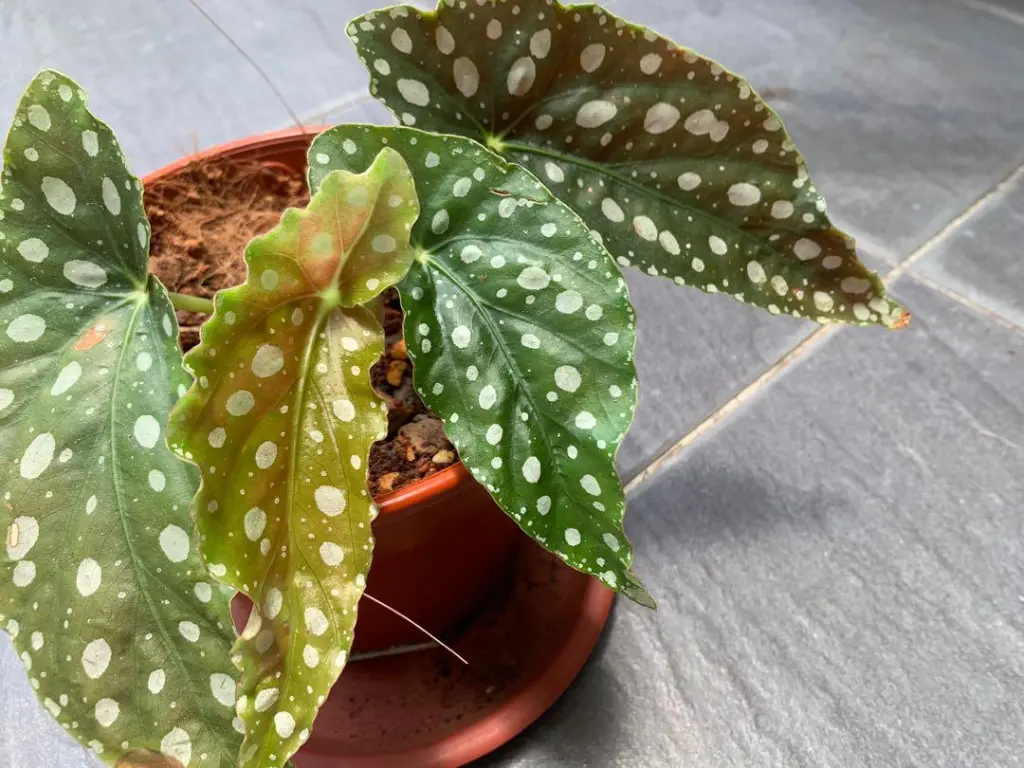
During the winter months, your White Angel Wing Begonia enters a period of dormancy. This is the time to cut back on watering and fertilizing. Make sure to keep the plant in a warm spot with indirect light and avoid placing it near cold drafts.
Related Posts:
- 5 Secret Tips to Keep Your Houseplants Alive When You’re on Vacation
- Summer Houseplant Care: 7 Smart Tips for Lush Green Leaves
- 5 Trending Houseplants for 2025: Must-Have for Every Home
Common Issues and How to Fix Them
Even with the best care, sometimes issues can arise when growing White Angel Wing Begonias. Let’s explore some common problems and their solutions.
1. Yellowing Leaves
If you notice the leaves turning yellow, this could indicate overwatering, poor drainage, or a nutrient deficiency. Check the soil to ensure it’s not too wet, and ensure your pot has proper drainage.
2. Brown Leaf Tips
Brown tips on the leaves often signal underwatering or low humidity. Make sure you’re watering the plant consistently and increasing humidity if you’re in a dry environment. You can also trim the brown tips with clean, sharp scissors to keep the plant looking fresh.
3. Pest Problems
Pests like aphids and mealybugs can sometimes infest your White Angel Wing Begonia. Keep an eye out for any sticky residue or discolored leaves. If pests are present, gently wipe the leaves with a damp cloth and use an insecticidal soap to treat the infestation.
Frequently Asked Questions (FAQs)
1. How much sunlight does a White Angel Wing Begonia need?
White Angel Wing Begonias thrive in bright, indirect light. Avoid placing them in direct sunlight as it can scorch their leaves.
2. What type of soil is best for White Angel Wing Begonia?
A well-draining, moisture-retentive potting mix is ideal for this plant. Look for a mix designed for tropical plants or create your own by combining peat moss, perlite, and pine bark.
3. How do I prune my White Angel Wing Begonia?
Prune any damaged or yellowing leaves regularly to promote new growth. You can also trim back leggy growth to keep the plant compact and healthy.
4. Can I grow White Angel Wing Begonia indoors all year round?
Yes, White Angel Wing Begonias make excellent indoor plants and can grow year-round with the proper care. Just make sure they receive plenty of bright, indirect light and the right temperature.
Conclusion
Caring for a White Angel Wing Begonia may seem daunting at first, but with the right approach, it can be incredibly rewarding. By providing your plant with the right light, water, humidity, and occasional pruning, you’ll be rewarded with a stunning plant that adds beauty to your home.
Remember, each plant is unique, so take the time to observe your White Angel Wing Begonia’s specific needs. Whether you’re a seasoned gardener or just starting, these care tips will help you grow and enjoy this beautiful variety for years to come.
If you’re looking for more plant care tips or want to explore other types of begonias, check out our related articles on tropical houseplants and indoor gardening. Happy gardening!

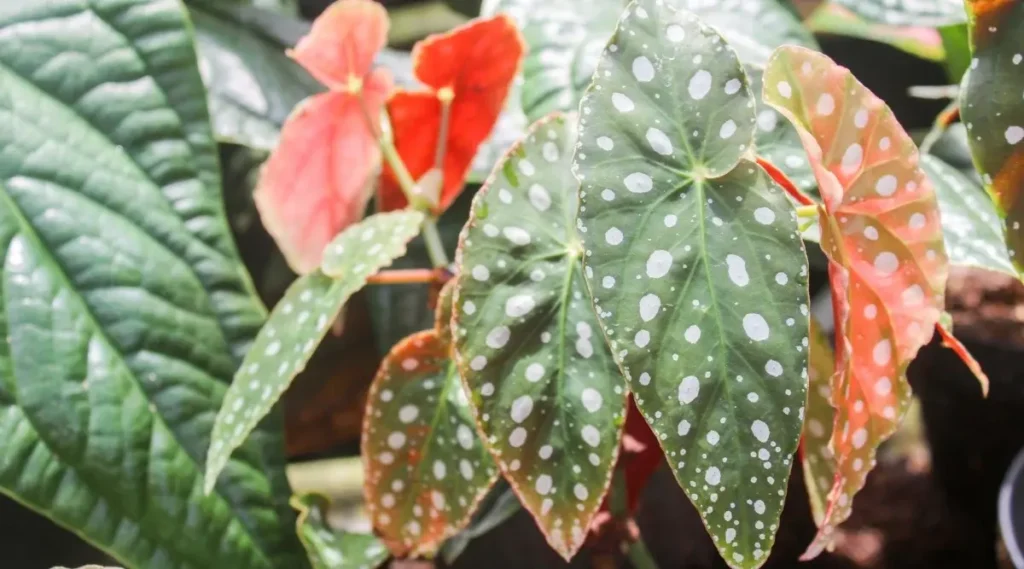
7 Vegetables to Plant in December for a Bountiful Winter Harvest
Winter gardening is a challenge many new gardeners shy away from. But if you’re among [...]
Dec
9 Common Christmas Cactus Problems and How to Fix Them
Have you ever walked past your Christmas cactus and wondered why it suddenly looks sad? [...]
Nov
Swedish Ivy Care: How to Grow a Healthy, Thriving Plant
Have you ever looked at your Swedish Ivy and wondered why the leaves are turning [...]
Nov
Avoid These 10 Garlic Planting Mistakes for Bigger, Healthier Bulbs
Growing garlic at home is one of the most satisfying things a gardener can do [...]
Nov
How to Prevent Christmas Cactus Bud Drop: Tips for a Healthy Bloom
Have you ever noticed your beautiful Christmas cactus (Schlumbergera) starting to lose its buds just [...]
Nov
Discover 7 Stunning Types of Night-Blooming Cereus
Have you ever waited for a flower that only opens at night and then disappears [...]
Nov